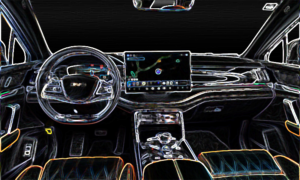Nos meses de março e abril, principalmente na região sudeste, há incidência de fortes chuvas e, muitas vezes, o motorista é obrigado a enfrentar enchentes ou locais com grandes quantidades de água na pista. Mesmo depois de atravessar trechos alagados com sucesso, não há garantias de que o veículo não tenha sofrido algum tipo de prejuízo. Nessa primeira foto, um claro exemplo de motor contaminado por água e até ´borra´.
Wilde Bueno, especialista em lubrificação da Mobil, explica a importância de consultar um mecânico de confiança, assim que possível, para fazer um check-up nas partes elétricas e no motor do veículo. É essencial conferir também os freios, a parte de baixo do veículo (uma vez que partículas de lixo podem se prender às peças), os filtros (ar, combustível e óleo) e o sistema de lubrificação do motor, entre outros itens. “No caso do óleo lubrificante, deve-se verificar a vareta de nível e checar a viscosidade e a cor do produto. Se houver alguma anormalidade, como aparência leitosa e coloração que vai do creme ao café com leite, é provável que tenha entrado água no sistema”, enfatiza o especialista. Neste caso, é preciso trocar o óleo imediatamente porque o produto perde suas propriedades com a invasão da água. O mecânico deve realizar uma limpeza geral: esvaziar o óleo do cárter, limpar as velas e trocar o óleo e o filtro de óleo. “O bom lubrificante minimiza o atrito das partes internas do motor, assegurando seu funcionamento. Logo, usar o veículo com o lubrificante contaminado com água pode trazer sérios problemas como a quebra da película lubrificante, possibilitando contatos metálicos e desgaste das peças e até mesmo causar o fatal motor-fundido”, destaca Bueno.
Dica de segurança >> Caso o motorista se veja em meio a uma enchente, é possível tomar algumas medidas para manter a segurança dos passageiros e prejudicar o menos possível o veículo. Observe a altura do nível de água do trecho alagado e só atravesse se não ultrapassar o centro da roda. Esta é a altura de segurança para deixar o escapamento fora da água. Uma vez na água, o carro deve ser dirigido em baixa velocidade, em rotação constante do motor, em torno de 2.500 rpm. Não troque a marcha, para não correr o risco de o veículo morrer, e não force o acelerador, para não criar uma marola na frente do carro e permitir que a água entre no motor. Se o motor “morrer” durante a travessia, não dê a partida. Mantenha o carro desligado e remova-o apenas quando a água baixar. O ideal é guinchar o veículo até uma oficina, pois pode ser que tenha entrado água no motor e, funcioná-lo nestas condições, aumenta o risco de danos causados por calço hidráulico. É recomendado, também, desligar o sistema ar-condicionado durante a travessia.
Sobre a Mobil >> Licenciada para a Cosan Lubrificantes no Brasil, Paraguai, Uruguai, Bolívia, Inglaterra, Espanha e Irlanda, a marca Mobil é reconhecida mundialmente por sua boa qualidade em lubrificantes automotivos e industriais de máxima performance. Mais informações: www.mobil.cosan.com (Fotos: divulgação) //// Abaixo, texto traduzido para o inglês (Below, translated text in english)
Service – it´s necessary to change the oil after crossing flooded snippets? >> In the months of march and april, mainly in the southeast of Brazil, there is incidence of heavy rains and, often, the driver is obliged to face flooding or places with large amounts of water on the track. Even after crossing passages flooded with success, there is no guarantee that the vehicle has suffered some kind of injury.
Mr. Wilde Bueno, Mobil lubrication specialist, explains the importance of consulting a reliable mechanic, as soon as possible to get a check-up on the electric parts and the engine of the vehicle. It is essential to check also the brakes, the bottom part of the vehicle (since particles can cling to the garbage pieces), filters (air, fuel and oil) and the engine lubrication system, among other items. “In the case of lubricating oil, check the dipstick and check the viscosity and the color of the product. If there is any abnormality such as milky appearance and coloration ranging from cream to coffee with milk, is likely to have entered the water system”, emphasizes the expert. In this case, you must change the oil immediately because the product loses its properties with the invasion of water. The mechanic must perform a general cleaning: drain the crankcase oil, clean the candles and change the oil and oil filter. “The good Lube minimizes the friction of the internal parts of the engine, ensuring its operation. Soon, use the vehicle with the lubricant contaminated with water can bring serious problems such as the breakdown of the lubricant film, allowing metallic contacts and wear of parts and even cause the fatal engine-fused”, say Bueno.
Safety Tip >> If the driver is in the midst of a flood, you can take some steps to maintain the security of the passengers and impair as little as possible the vehicle. Note the height of the water level in the flooded stretch and only cross if not exceed the centre of the wheel. This is the time to let security leakage out of the water. Once in the water, the car must be driven at low speed, in constant rotation of the engine around 2500 rpm. Do not change gait, not to run the risk of the vehicle die, and do not force the accelerator, not to create a swell in the front of the car and allow water to enter the engine. If the engine “die” during the crossing, did not start. Keep the car off and remove it only when the water drops. The ideal is to tow the vehicle to a repair shop, because I might have gotten water in the engine, and run it under these conditions, increases the risk of damage caused by hydraulic wedge. It is recommended, too, turn off the air-conditioning system during the crossing.











